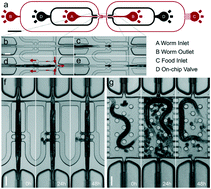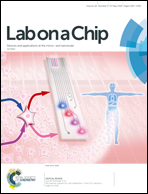Long-term C. elegans immobilization enables high resolution developmental studies in vivo†
Abstract
Live-imaging of C. elegans is essential for the study of conserved cellular pathways (e.g. EGFR/Wnt signaling) and morphogenesis in vivo. However, the usefulness of live imaging as a research tool has been severely limited by the need to immobilize worms prior to and during imaging. Conventionally, immobilization is achieved by employing both physical and chemical interventions. These are known to significantly affect many physiological processes, and thus limit our understanding of dynamic developmental processes. Herein we present a novel, easy-to-use microfluidic platform for the long-term immobilization of viable, normally developing C. elegans, compatible with image acquisition at high resolution, thereby overcoming the limitations associated with conventional worm immobilization. The capabilities of the platform are demonstrated through the continuous assessment of anchor cell (AC) invasion and distal tip cell (DTC) migration in larval C. elegans and germ cell apoptosis in adult C. elegans in vivo for the first time.



 Please wait while we load your content...
Please wait while we load your content...